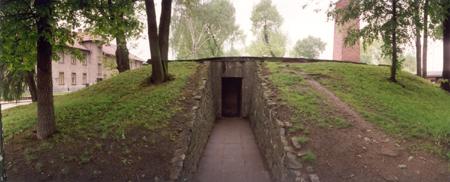
Entrance to Crematorium I, Auschwitz I
The Commandant of Auschwitz, Rudolf Hoss, was hung just outside of this crematorium on April 16, 1947. The building was originaly an ammunition depot. It was adapted for use as a crematorium, but only to burn the bodies of prisoners who had died in confinement. Later it was re-adapted into a gas chamber and crematorium combination.
The victims would enter this door, which would be hermetically sealed. The victims would then be in the gas chamber. There was no undressing room, and the victims had to be paraded in sight of the whole camp, which had a demoralizing effect. These defects would be corrected in crematoria II, III, IV and V, which were located in remote areas of Birkenau camp.
After the war this building was partially reconstructed--including rebuilding the chimney and installing 3 ovens that were built for another camp. The SSSS: (Schutzstaffel, Protection Squad), originally Adolf Hitler’s bodyguard, it became the elite guard of the Nazi state and its main tool of terror. The SS maintained control over the concentration camp system and was instrumental in the mass shootings conducted by the Einsatzgruppen.
Led by Heinrich Himmler, its members had to submit with complete obedience to the authority of the supreme master, Hitler and himself. SS officers had to prove their own and their wives’ racial purity back to the year 1700, and membership was conditional on Aryan appearance.
In the charter of the International Military Tribunal at Nuremberg (commonly known as the Nuremberg War Crimes Trials) the SS was held to be a criminal organization. Its members were considered war criminals involved in brutalities and killings in the concentration camps, mass shootings in the occupied countries, involvement in the slave labor program and the murder of prisoners-of-war. Source: Encyclopedia of the Holocaust. headquarters building can be seen to the left.
Photo Credit: John Menszer